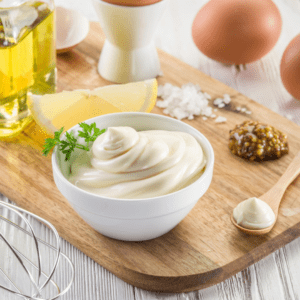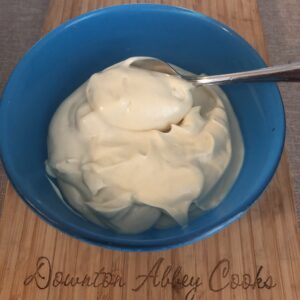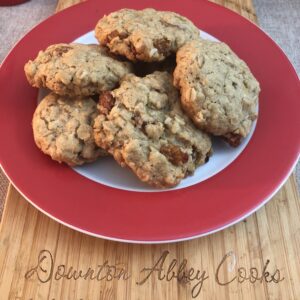Jump to Recipe
 With food prices on the rise, home bakers are looking for ways to cut costs without sacrificing taste. Fortunately, there’s one versatile ingredient already in most kitchens that can help: mayonnaise.
With food prices on the rise, home bakers are looking for ways to cut costs without sacrificing taste. Fortunately, there’s one versatile ingredient already in most kitchens that can help: mayonnaise.
Believe it or not, mayonnaise can be used to replace eggs, oil, butter, and more in baked goods. While unfamiliar as an baking ingredient, mayo has some properties that make it ideal for economizing desserts and breads without diminishing flavor. Here’s why mayo works so well, along with tips for how to successfully use it in your baking.
The Basics of Mayo
First, let’s look at what mayonnaise is and why it functions the way it does in recipes. Mayonnaise has an emulsified texture because it is made from oil, egg yolks, and an acidic liquid like lemon juice or vinegar. These ingredients are combined and whipped together to create a thick, creamy condiment.
The egg yolks act as an emulsifier, allowing the oil and water to blend together smoothly. They also provide fat, richness, and binding qualities. Meanwhile, the oil lends moisture and fat. The acid helps stabilize the emulsion and adds tanginess.
Altogether, these components make mayo a handy substitute for costlier ingredients. The emulsified texture mimics the fat and moisture provided by butter. The egg yolks offer protein and binding like eggs. And the neutral flavor of oils lets other flavors shine. With the right technique, it seamlessly integrates into batters and doughs.
Replacing Eggs
Eggs can be one of the pricier ingredients in baked goods. Luckily, mayo makes an excellent egg substitute. The egg yolks in mayo provide the same binding, leavening, and moisture that eggs do in baking.
As a general rule, you can replace one whole egg with 1/4 cup of mayonnaise. So if a recipe calls for two eggs, use 1/2 cup mayo. Beaten egg whites can still be added for lift if the recipe requires it. The result will be tender, rich baked goods with no detectable mayo flavor.
Try using mayo instead of eggs in cookies, muffins, quick breads, pancakes, and cakes for added moisture. Be sure to reduce any other liquid in the recipe by 1/4 cup per egg. The mayo will make the texture extra silky and decadent.
Cutting Oil and Butter
With its high oil content, mayonnaise can also stand in for some or all of the butter or oil in recipes. This shaves calories and saturated fat without compromising moisture and richness.
In cookies, brownies, muffins and cakes, try replacing 1/4 of the butter or oil with mayo. The emulsified texture integrates seamlessly, while the egg yolks keep things tender and Velvety. For box mixes, simply replace the oil with an equal amount of mayonnaise.
In rich recipes like pound cakes or oil-based cakes, you can even replace all the butter or oil with mayo for an extremely decadent crumb. Add a little extra leavening like baking powder to compensate for the lost lift from creamed butter.
You can also use mayo in place of half the butter when making grilled cheese, fried foods, or spreading on biscuits before baking. The oil and egg yolks help foods get beautifully browned and crisp.
Baking Tips
To ensure success when baking with mayo, follow these tips:
– Let ingredients come to room temperature. This helps the mayo emulsify smoothly into batters.
– Shake the jar before measuring. This evenly distributes the oil for accurate measurements.
– Use full-fat mayo for best moisture and richness. Low-fat mayo won’t provide the same effects.
– Under-mix lumpy batters after adding mayo. Overmixing can cause cakes to collapse or get gummy.
– Add a touch of lemon juice or vinegar to replicate mayo’s tanginess if needed.
Here is a new section added about making your own mayonnaise:
Make Your Own and Save Even More
For maximum savings, consider making your own mayonnaise at home. It’s surprisingly quick and easy to make with just a few basic ingredients.
Homemade mayo has a fresher taste and creamier texture than store-bought. It also allows you to control the type of oil used, which can further cut costs. Olive oil or avocado oil mayonnaise can be pricey, but you can replicate them economically with canola or vegetable oil at home.
Making your own mayo to use in baking provides even more savings while allowing you to customize flavors. Add dried herbs, smoked paprika, roasted garlic, or other mix-ins to create signature mayos for different recipes.
So don’t be afraid to get hands-on and make mayo from scratch. It takes just minutes to whip up and gives you greater versatility to bake on a budget.
Make your Own Mayonnaise in Minutes
Equipment
Ingredients
- 2 large eggs room temperatue
- 2 tbsp. Dijon mustard
- 2 tbsp. red or white wine vinegar
- 1/2 tsp. kosher salt or more to taste
- 2 cups canola or vegetable oil
- 2 tsp. fresh lemon juice optional
Instructions
- You can whisk by hand, but easier done with a hand blender or in a food processor. All your ingredients need to be at room temperature to get the best results.
- Beat the raw eggs for 20 seconds Add the mustard, vinegar, and salt and beat for another 20 seconds.
- Slowly drizzle the oil, in drops at first for the first 1/2 cup beating as you go. Once incorporated you can increase the flow to a thin stream. Like magic the mixture will thicken and will emulsify.
- Once thick, you can stop beating. Taste for seasoning and add more salt, vinegar or lemon juice to taste.
- Pour into a jar with a lid and store in the fridge. I write the date on the side of the jar. It will keep for at least a week, but I have not had any issues storing it for a month.
The Takeaway
With creativity and proper technique, mayonnaise can be a home baker’s secret budget saver without sacrificing moistness or flavor. Try using mayo instead of eggs, butter, or oil in your next baking project to enjoy decadent results on a budget.
Try Making Cookies with Mayo
Oatmeal Cookies With Mayo
Ingredients
- 1 cup rolled oats
- 1 cup unbleached all-purpose flour
- 1/2 cup sugar
- 3/4 cup mayonnaise
- 1/2 cup raisins or chocolate chips optional
- 1/2 tsp. baking soda
- 1/2 tsp. cinnamon
- 1/4 tsp. salt
- 1/2 tsp. vanilla extract
Instructions
- Preheat your oven to 350°F (175°C) and line a baking sheet with parchment paper.
- In a mixing bowl, combine the rolled oats, all-purpose flour, sugar, baking soda, cinnamon, and salt.
- Add the mayonnaise and vanilla extract to the dry ingredients. Mix well until a cookie dough forms. You may find using your hands easier to mix the ingredients. Add a little more mayo if too dry.
- If you'd like, you can add raisins or chocolate chips to the dough and mix them in evenly.
- Use a cookie scoop to form round balls and space a few inches apart onto the prepared baking sheet, spacing them a few inches apart. Press the balls down.
- Bake in the preheated oven for about 10-15 minutes, or until the edges of the cookies turn golden brown.
- Remove the cookies from the oven and let them cool on the baking sheet for a few minutes before transferring them to a wire rack to cool completely.
Nutrition


